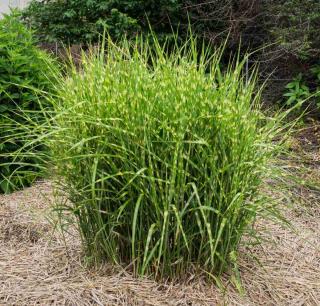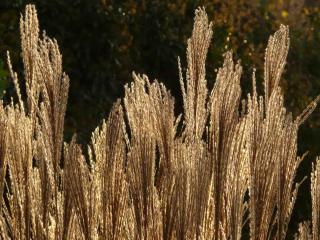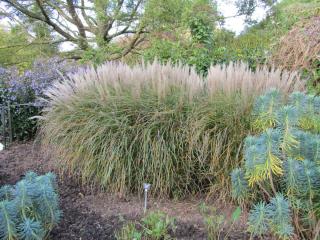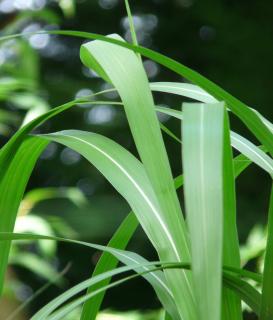

Chinese reed, or Miscanthus sinensis, with its broad silhouette, is likely one of the most beautiful and least invasive giant grasses in our temperate regions.
This lazy gardener’s plant suits rustic style gardens, minimalist contemporary gardens, and Zen gardens all very well.
 All in all, Miscanthus is pretty accommodating, though it prefers rich and moist soils. It handles occasional dryness and ordinary, dry, or heavy soils without a hitch. These factors, however, affect its fall colors and the persistence of its stalks and foliage in winter. Plant it in the sun in a large but well-drained hole.
All in all, Miscanthus is pretty accommodating, though it prefers rich and moist soils. It handles occasional dryness and ordinary, dry, or heavy soils without a hitch. These factors, however, affect its fall colors and the persistence of its stalks and foliage in winter. Plant it in the sun in a large but well-drained hole. Just avoid trimming Miscanthus canes at the start of winter, or it might not grow back. Cut dried clumps back to 6 inches from the ground at the end of winter. This is when nitrogen in the canes migrates to the rhizomes for spring regrowth. It’s only at the end of winter that Miscanthus loses its dry foliage, forming a welcome mulch to promote regrowth and keep the soil cool.
Just avoid trimming Miscanthus canes at the start of winter, or it might not grow back. Cut dried clumps back to 6 inches from the ground at the end of winter. This is when nitrogen in the canes migrates to the rhizomes for spring regrowth. It’s only at the end of winter that Miscanthus loses its dry foliage, forming a welcome mulch to promote regrowth and keep the soil cool. Loving fresh soils, you can plant Miscanthus near a pond or to give volume by a basin.
Loving fresh soils, you can plant Miscanthus near a pond or to give volume by a basin.The home ground of this giant grass is Africa and South Asia (surprisingly, given its common name). It thrives in marshes and also on drained slopes and hillside flanks. It even has the nickname “Elephant Grass”, which it shares with some types of bana grass.
The linear foliage of the Miscanthus sinensis forms an imposing bundle, 5 to 6½ feet (1.50 to 2m) in all directions, crowned by silver panicles turning violet brown when mature. In autumn, the green foliage shifts to yellow, orange, red, or brown tones depending on the cultivar. Its well-defined silhouette, even in winter as its leaves and inflorescences dry out, also adds appeal.
Given its success, numerous cultivars have sprung up, including:
 Fine foliage forms like ‘Rotsilber’ with late flowering, standing just above a wide, dark green foliage marked by a silver central rib.
Fine foliage forms like ‘Rotsilber’ with late flowering, standing just above a wide, dark green foliage marked by a silver central rib.*The first number indicates the height of the foliage, the second, that of the flowering.
Facing space constraints, forms of small dimensions have been selected:
Miscanthus x giganteus, a sterile form, is emerging as a plant of the future. Think biomass for methane production, biofuel, particle boards, insulation, PVC substitutes, and so on. Harvest its dry canes at the end of winter and you’ve got yourself some firewood. It releases less carbon dioxide when burned than wood. And it packs more heat than a wood chip. Talk about hot stuff!